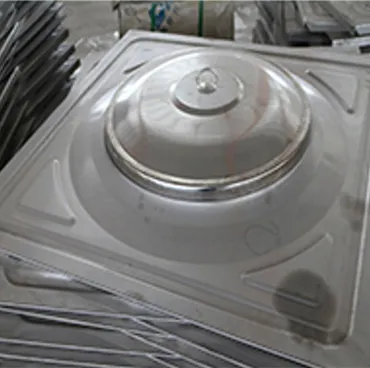loading...
- No. 9, Xingyuan South Street, Dongwaihuan Road, Zaoqiang County, Hengshui, Hebei, China
- admin@zjcomposites.com
- +86 15097380338
- Welcome to visit our website!
frp solar structure
Frp Solar Structure Revolutionizing Renewable Energy Infrastructure
In the pursuit of sustainable energy sources, the integration of advanced materials into solar energy systems has become increasingly vital. One of the most promising innovations in this field is the development of fiber-reinforced polymer (FRP) solar structures. FRP materials, known for their lightweight, strength, and corrosion resistance, offer numerous advantages for the deployment and longevity of solar photovoltaic (PV) systems. This article explores the significance of FRP solar structures, their benefits, applications, and future potential in enhancing renewable energy infrastructure.
Understanding FRP Materials
Fiber-reinforced polymers are composites made from a polymer matrix reinforced with fibers, typically glass or carbon. These materials are designed to provide enhanced mechanical properties, making them suitable for various applications, including construction, automotive, and aerospace industries. In the context of solar energy, FRP structures are crafted to support solar panels, ensuring they withstand environmental stresses while maintaining efficiency in energy conversion.
Advantages of FRP Solar Structures
1. Lightweight Nature One of the most compelling features of FRP materials is their lightweight characteristic. Unlike traditional materials such as steel or concrete, FRP is significantly lighter, allowing for easier transportation and installation. This property is particularly beneficial for rooftop installations where the structural load on buildings must be minimized.
2. Corrosion Resistance FRP structures exhibit excellent resistance to corrosion, making them ideal for use in harsh environmental conditions, such as coastal areas where saltwater can lead to rapid deterioration of traditional materials. This longevity reduces maintenance costs and enhances the overall lifespan of solar installations.
3. High Strength-to-Weight Ratio The strength-to-weight ratio of FRP is exceptionally high, providing robust support for solar panels against wind, snow loads, and other dynamic forces. This attribute not only ensures the structural integrity of the solar power system but also allows for design flexibility in various installation scenarios.
4. Thermal Insulation FRP materials contribute to improved thermal insulation, which can be advantageous in mitigating heat loss and enhancing the efficiency of solar panels. This quality is particularly essential in regions with extreme temperature fluctuations.
5. Environmental Sustainability The production and use of FRP materials contribute to a reduction in carbon footprint compared to traditional materials. Many manufacturers are now focusing on eco-friendly production processes and the recyclability of FRP, aligning with global sustainability goals.
frp solar structure

Applications of FRP Solar Structures
FRP solar structures can be employed in various applications, including
- Rooftop Solar Installations The lightweight nature and corrosion resistance of FRP make it an excellent choice for supporting solar panels on rooftops. This is especially beneficial for buildings with weight restrictions.
- Solar Carports FRP can be utilized to create solar carports that provide shade for vehicles while simultaneously generating electricity from solar panels. These structures can be integrated into commercial or residential properties, maximizing land use.
- Ground-Mounted Systems In large-scale solar farms, FRP can enhance the durability and stability of ground-mounted solar panels. The corrosion resistance of FRP structures ensures that they endure the elements without extensive maintenance.
Future Potential
As the demand for renewable energy continues to rise, the role of FRP in solar technology is expected to grow significantly. Ongoing research and development are likely to yield new formulations and applications of FRP materials, further improving performance and reducing costs. Additionally, policy incentives and advancements in manufacturing techniques could promote the widespread adoption of FRP solar structures across various markets.
Conclusion
In conclusion, FRP solar structures represent a significant advancement in the renewable energy sector, offering a combination of lightweight, strength, and durability that traditional materials cannot match. As the world moves towards a more sustainable future, the integration of innovative materials like FRP in solar energy systems will play a crucial role in enhancing efficiency, reducing costs, and promoting environmental sustainability. By embracing these technologies, we can continue to harness the sun’s power more effectively, contributing to a greener and more sustainable planet.
-
The Rise of FRP Profiles: Strong, Lightweight, and Built to LastNewsJul.14,2025
-
SMC Panel Tanks: A Modern Water Storage Solution for All EnvironmentsNewsJul.14,2025
-
GRP Grating: A Modern Solution for Safe and Durable Access SystemsNewsJul.14,2025
-
Galvanized Steel Water Tanks: Durable, Reliable, and Ready for UseNewsJul.14,2025
-
FRP Mini Mesh Grating: The Safer, Smarter Flooring SolutionNewsJul.14,2025
-
Exploring FRP Vessels: Durable Solutions for Modern Fluid HandlingNewsJul.14,2025
-
GRP Structures: The Future of Lightweight, High-Performance EngineeringNewsJun.20,2025
